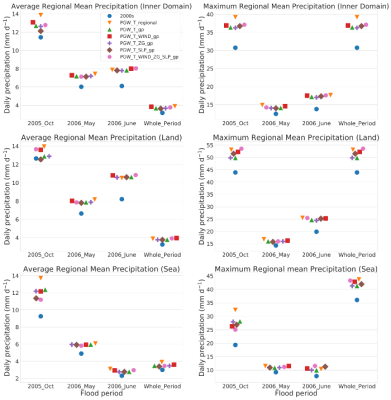Sensitivity of the Pseudo-Global Warming Method Under Flood Conditions: A Case Study from the Northeastern U.S.
Climate models are the most widely used tool in climate science, but their coarse resolution makes regional modeling and downscaling necessary for local studies. In the recent decade, the pseudo-global warming method has become increasingly popular as it can estimate the impacts of returned historical extreme events with reduced modeling uncertainties. However, there is little guidance on the best practices for using the PGW method. By conducting a set of PGW experiments during three flood periods, we first quantify the sensitivity of PGW methods and provide guidelines for the regional climate community to further reduce uncertainties in climate projections. This work also sets the stage for following studies over a broader scope of the experimental design of the PGW method.
By conducting multiple PGW experiments with varied perturbation spatial scales and choice of perturbed meteorological variables, we solve three critical unsolved questions related to the application of the PGW—at what spatial scale should climate perturbations be applied? Among the different meteorological variables available, which ones should be perturbed? And will PGW projections vary significantly when different perturbations are applied? Finally, we conclude that PGW experiments with perturbations from temperature or the combination of temperature and wind at the grid point scale are both recommended, depending on the research questions. The first approach can isolate the spatially dependent thermodynamic impact, and the latter incorporates both the thermodynamic and dynamic impacts.
Intensified extreme precipitation and the resulting floods represent the most significant consequences of climate change in the northeastern US (NEUS) region. To assess the impact of climate change or specific climate perturbations on future extreme weather events that resemble historical analogs in terms of dynamics, the pseudo-global warming (PGW) method has been frequently utilized. However, this method lacks a precise definition and guidelines, which restricts its applicability. Specifically, three crucial questions regarding the implementation of the PGW method remain unanswered: What spatial scale should climate perturbations be applied at? Which meteorological variables should be perturbed among the available options? And how significantly do PGW projections vary when different perturbations are applied?
To address these inquiries, we examine the sensitivity and robustness of conclusions derived from the PGW method in the NEUS region. We conduct multiple PGW experiments with varying spatial scales of perturbations and selection of perturbed meteorological variables. The findings demonstrate that the projections of precipitation and other essential variables at the regional mean scale remain consistent across the PGW simulations, with a relative difference of less than 10%. However, different modifications to perturbations can cause significant shifts in the simulated storm events. Previously assumed advantages of solely modifying the temperature at the regional mean scale, such as preserving geostrophic balance, do not appear to hold true. Additionally, in these experiments, we observe a positive precipitation bias resulting from regional mean perturbations, as they disregard the land-ocean warming contrast, which is a robust regional response to global warming.
Overall, we recommend conducting PGW experiments with perturbations from temperature alone or a combination of temperature and wind at the grid point scale, depending on the research questions at hand. The former approach enables the isolation of spatially dependent thermodynamic impacts, while the latter incorporates both thermodynamic and dynamic influences.

